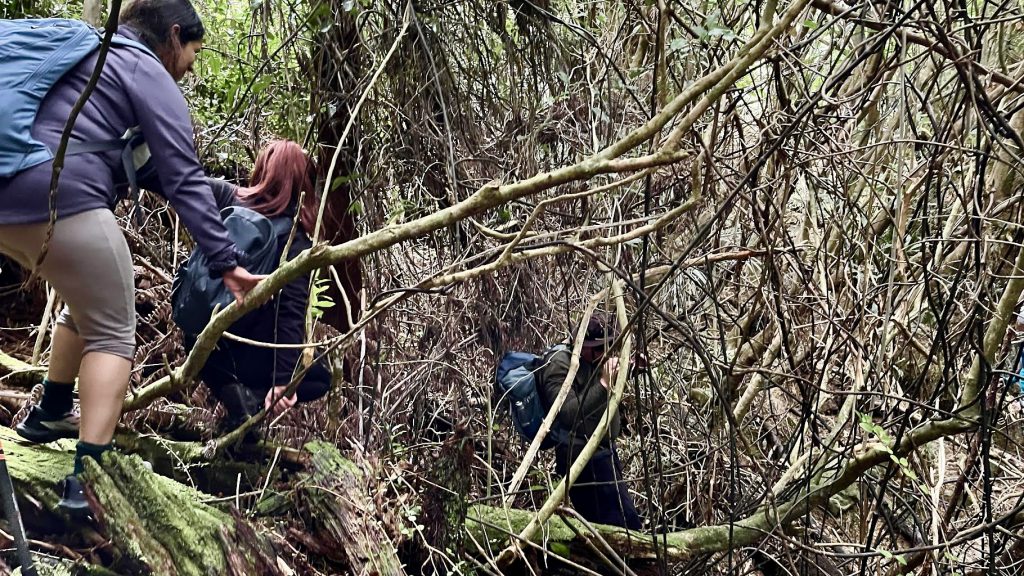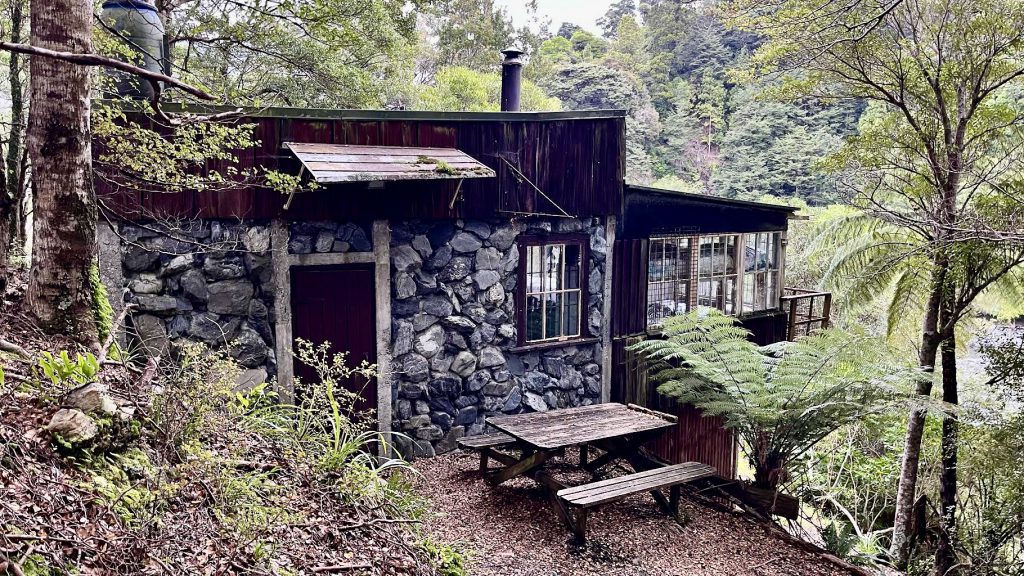The trip schedule proposed an Ōrongorongo hut-bagging trip, with a particular focus on visiting Baine-Iti and Goat Stream Huts. There are many private huts in the Ōrongorongo Valley, so the precise trip plan could be as relaxed or ambitious as the group desired. Eight people were keen for this spontaneous adventure. We carpooled to Catchpool car park and we were walking by about 9am.
We passed a few groups on the Main Track, who were heading back to the car park, but overall the track was quite quiet. Having crossed the curved bridge (ie the bridge over Turere Stream), we headed along the Big Bend track towards the first of the huts.
Monique led from the front, doing an expert job pointing out huts off to the side of the track. In short order, we visited Omaio Hut, Fern Lodge and arrived at Turere Lodge. This is where we did the first proper bush-bash of the day, with several of us exploring makeshift paths to locate Boulder Lodge.
Following this, it was helpful to have a group chat to be clear about who was keen to go off on side trips to different huts, and setting turnaround times for each side trip – to help ensure people didn’t get lost and that the group stayed together.
Continuing north-east, we decided not to bush-bash up the hill to find several huts, opting instead to stay on the main track and visit Manuka Hut and Haurangi Hut. We then crossed the Ōrongorongo River and arrived at Baine-Iti Hut at about midday. We were very fortunate that the river was flowing at a leisurely rate of less than 1 cubic metre per second; less than 12 hours later it would spike to over 150 cubic metres per second, as Sunday and Monday’s rain hit!

We enjoyed reading about the history of Baine-Iti Hut, had a lunch and were walking back down the Ōrongorongo riverbed by 12.30pm. Despite a few cold stream crossings, it was nice to have the variety of covering different terrain in each direction.

We were expecting it to be more difficult to locate huts on the eastern side of the river, but were pleasantly surprised that several could be readily accessed from the riverbed. Megan and Monique led the charge, identifying paths that we could explore further. A path up to Rovers Return Hut linked up with a path to Tijuana Hut – both of which were in immaculate condition and clearly well looked after. Similarly, a 4WD drive led directly to Wai-iti Hut from the riverbed.
Further down river, we found the spur (and path) to the true right of Goat Stream. This lead us to Goat Stream Hut. Then, after retracing our steps about 50 m, we went north to visit Camp Two. From here, it was a bush-bash for a couple of hundred metres to find Sunny Bank Hut.
We had started out behind the Camp Two toilet. However, on the return trip we followed a path which had views of the river and it took us almost all the way back to Camp Two before we had to fight through ‘Shelob’s Lair’1 (about 20 m of supplejack).


Before returning to the car park, we climbed the very well maintained 4WD track to admire Xanadu Hut. This hut is situated on the eastern side of Big Bend. With its lovely views over the river, adjacent beech forest and the stone work on the hut itself, this was a great way to end the day.
We walked back to the car park with the satisfaction of having visited 14 huts (out of approximately 33 huts) in the vicinity of where we planned to walk. All in all, it was an enjoyable day and we obtained a greater appreciation for the history of the area and the passion with which the private huts are maintained.
Statistics from Garmin watch: 20.20 km travelled, 6 hr 45 mins elapsed time, 5 hrs 20 mins moving time, 643 m ascent, 637 m descent.
- Editor’s note: This is a reference to tunnels of spider webs, where the enormous spider, “Shelob”, lives – from the Lord of the Rings trilogy of books ↩︎


The rovers return hut was owned by the Barclays family in the 70s , they lived in Kim street in Wainui, mr Barclays had one of the first Toyota Land Cruisers and it was often seen in the riverbed as back then you could access the valley by vehicle anytime .